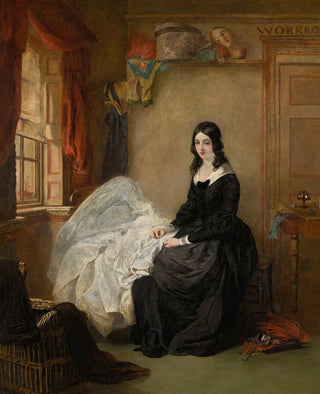Art print | Kate Nickleby and Madame Mantalini - William Powell Frith


View from behind

Frame (optional)
William Powell Frith’s "Kate Nickleby and Madame Mantalini" art print stands out in the vibrant world of Victorian painting for its rich narrative and meticulous attention to detail. This scene, adapted from Charles Dickens' renowned novel, brilliantly illustrates social intrigues and power dynamics within 19th-century English society. Frith, a true chronicler of his era, captures the essence of his characters and the emotions that animate them. The art print of this masterpiece offers a fascinating gateway into a world where drama and comedy intertwine, inviting viewers to immerse themselves in the subtleties of daily life in London.
Style and uniqueness of the work
Frith’s style is characterized by a naturalist approach, emphasizing facial expressions and postures of the characters. In "Kate Nickleby and Madame Mantalini," each figure is carefully crafted, revealing complex emotions and delicate interpersonal relationships. The composition, with its numerous protagonists, creates a lively tableau where every detail matters. The richly adorned costumes and carefully selected accessories reflect an era when social appearance held great importance. Frith does not merely depict characters; he tells a story—one of aspirations, disillusionments, and struggles of his contemporaries. This ability to weave narratives through painting gives the art print a timeless dimension, captivating an audience always eager for human stories.
The artist and his influence
William Powell Frith, born in 1819, is often regarded as one of the greatest genre painters of his time. His career, marked by a series of emblematic works, helped shape the perception of Victorian art. Frith captured the customs of his era with remarkable acuity, addressing themes ranging from daily life to historical events. His influence extends beyond his own artistic production, inspiring many contemporary and future artists. By incorporating narrative elements into his compositions, he paved the way for a new form of expression in

Matte finish

View from behind

Frame (optional)
William Powell Frith’s "Kate Nickleby and Madame Mantalini" art print stands out in the vibrant world of Victorian painting for its rich narrative and meticulous attention to detail. This scene, adapted from Charles Dickens' renowned novel, brilliantly illustrates social intrigues and power dynamics within 19th-century English society. Frith, a true chronicler of his era, captures the essence of his characters and the emotions that animate them. The art print of this masterpiece offers a fascinating gateway into a world where drama and comedy intertwine, inviting viewers to immerse themselves in the subtleties of daily life in London.
Style and uniqueness of the work
Frith’s style is characterized by a naturalist approach, emphasizing facial expressions and postures of the characters. In "Kate Nickleby and Madame Mantalini," each figure is carefully crafted, revealing complex emotions and delicate interpersonal relationships. The composition, with its numerous protagonists, creates a lively tableau where every detail matters. The richly adorned costumes and carefully selected accessories reflect an era when social appearance held great importance. Frith does not merely depict characters; he tells a story—one of aspirations, disillusionments, and struggles of his contemporaries. This ability to weave narratives through painting gives the art print a timeless dimension, captivating an audience always eager for human stories.
The artist and his influence
William Powell Frith, born in 1819, is often regarded as one of the greatest genre painters of his time. His career, marked by a series of emblematic works, helped shape the perception of Victorian art. Frith captured the customs of his era with remarkable acuity, addressing themes ranging from daily life to historical events. His influence extends beyond his own artistic production, inspiring many contemporary and future artists. By incorporating narrative elements into his compositions, he paved the way for a new form of expression in






